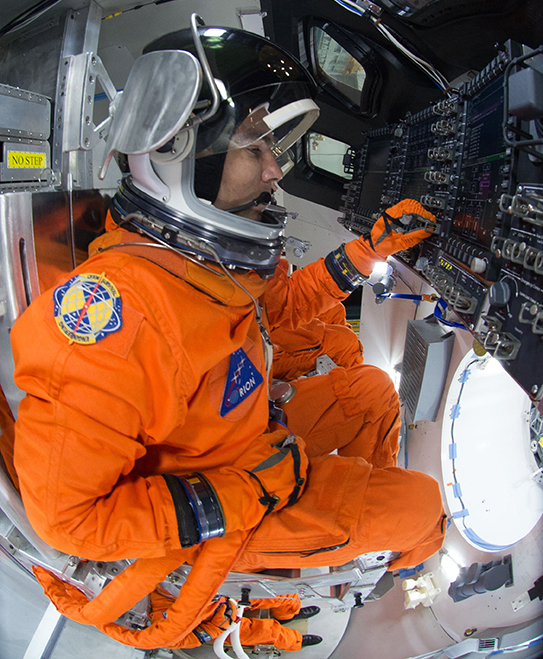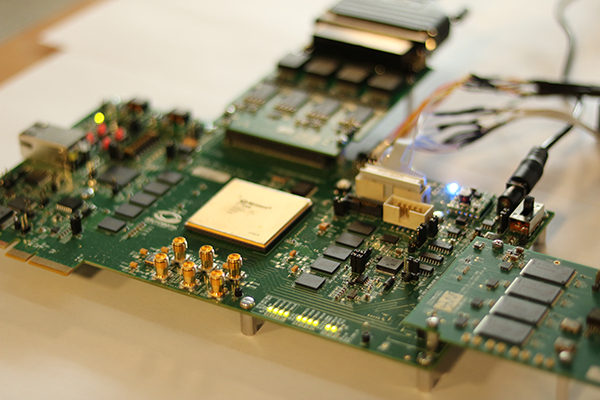
NASA Helps Make Connections in Air and Space
Subheadline
Industry benefits from networking hardware designed for Orion
Your home internet router has more in common with the Orion spacecraft than you’d think.
Both use a standard known as Ethernet to send communications between computer systems. Ethernet is ubiquitous throughout this world, but it has some applications that are out of it.
Many Ethernet connections require a piece of hardware called a switch, which takes one connection and splits it between several computers. These components are necessary in environments such as office buildings or schools, where hundreds of people share an internet connection. Unlike an Ethernet switch on the ground, a switch on the Orion capsule needs to be lightweight and hardened against the extremes of space travel, including the stresses of launch aboard the world’s most powerful rocket.
“You’re not going to be able to find anything on the ground that will fly in space,” said Christine Bland, head engineer for Orion electronics at Lockheed Martin, which builds the spacecraft for NASA’s Johnson Space Center in Houston. “Orion has to go out and survive deep space and different radiation environments. It’s got to pass through the Van Allen belts, get hit with solar winds and galactic radiation ... the design has to encompass all of that.”
DornerWorks Ltd. of Grand Rapids, Michigan, was subcontracted to work on the Ethernet switch by another company building the Orion computer systems. The computers aboard Orion make up two distinct systems, one that controls crucial systems like guidance and life support, and another that manages data from all the spacecraft’s sensors. The latter includes everything from astronaut video conferences with the ground to views of the Moon from cameras outside the spacecraft. Ensuring this data gets where it needs to go requires speed, something Ethernet connections provide handily.
“It all comes down to performance, networking speed, and the number of connections,” said Gregg Wildes, business development director for DornerWorks. “This is human spaceflight – you need that for safety.”
Bland and the DornerWorks team worked to ensure the switch will be capable of everything necessary when crewed Artemis missions visit the Moon. The design can take in several telemetry streams and transmit them all back to Earth from the Moon, through all the cosmic radiation between.
“There weren’t solutions that were this small and this reliable in those environments,” Wildes said. “But now there are.”
DornerWorks kept the patent rights to the switch and now sells it to the commercial sector as a product called, aptly, “Space Switch.” However, the company largely licenses the design as intellectual property, allowing others to build it themselves. Customers include aircraft manufacturers and the automotive industry. Wildes says most companies use the Space Switch for something called time-sensitive networking, which is required for applications like self-driving cars.
“It’s all about, ‘Let’s get lots of data through very quickly,’” said Wildes. “You’ll have a guarantee for how long it’ll take to get from point A to point B.”
In the future, the company wants to leverage the technology it’s built for more applications, especially in the growing commercial space industry. But company leadership credits all the work for the Artemis program with helping the company get off the ground.
“Our work with NASA and the investment NASA put into DornerWorks and helping us get into different markets – it’s creating jobs,” said Lance Hilbelink, vice president of sales for DornerWorks. “It’s a benefit for Michigan.”

When astronauts fly aboard the Orion spacecraft during the Artemis II mission, data on their status will be crucial on the ground. DornerWorks’ network switch allows information to be quickly routed where it needs to go, whether inside the spacecraft or out. Credit: NASA

While designed for the Orion spacecraft, the Ethernet switch created by DornerWorks can be used in many applications that require fast networking, such as self-driving cars. Credit: DornerWorks Ltd.

Earth is visible from the Orion spacecraft as it circles the Moon during the Artemis I mission. The capsule’s systems are connected via an Ethernet switch to transmit data from cameras and other sensors back to Earth. This switch design is now used in other commercial products. Credit: NASA













